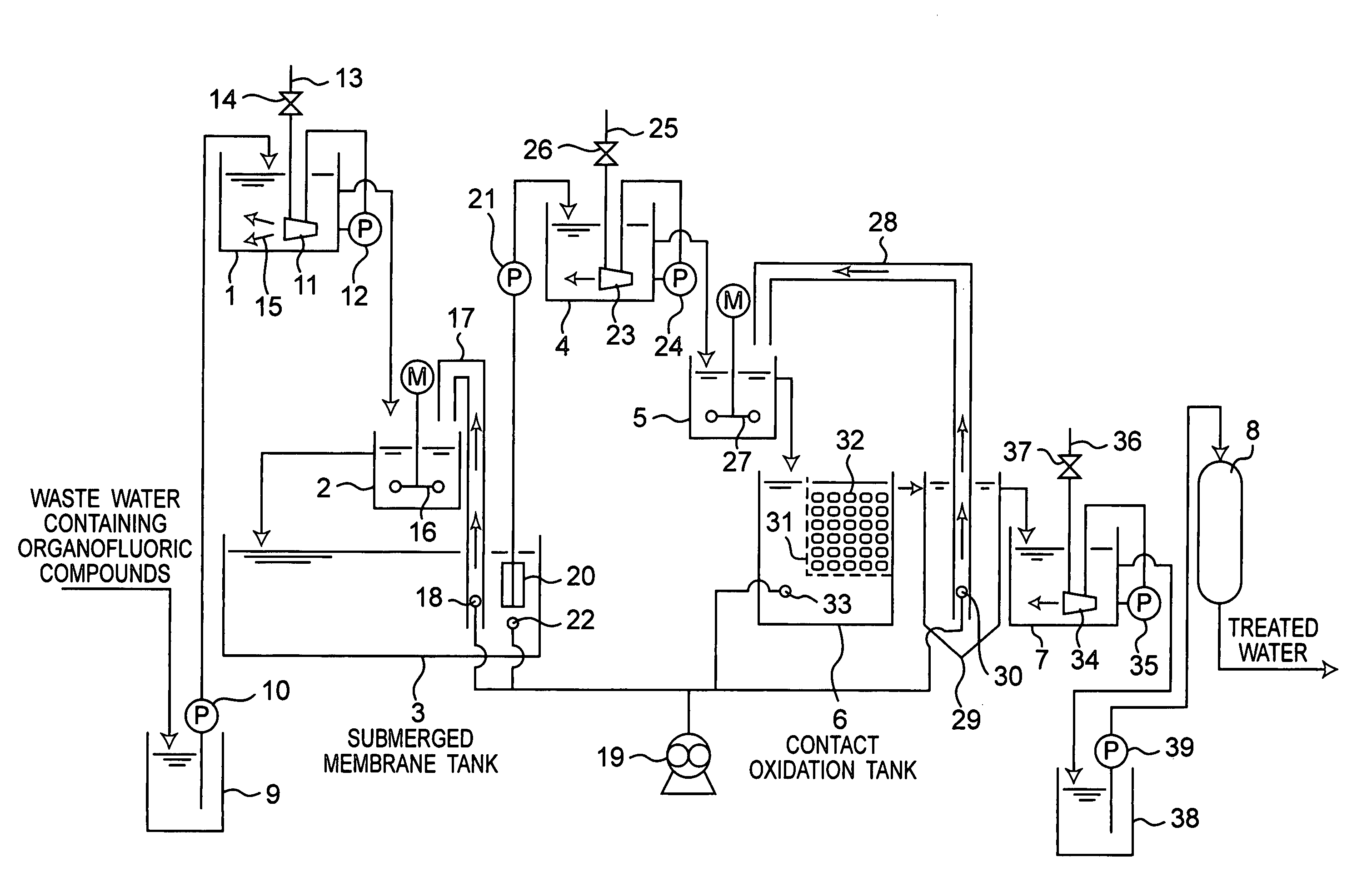Waste water treatment method and waste water treatment apparatus
a technology of waste water treatment and waste water treatment, which is applied in the direction of chemistry apparatus and processes, biological water/sewage treatment, sustainable biological treatment, etc., can solve the problems of affecting the ecosystem, affecting the effect of ecosystem health, and difficult to decompose pfos or pfoa in such a conventional treatment as to use microorganisms, photocatalysts or the like, so as to effectively decompose the organic compounds contained in
- Summary
- Abstract
- Description
- Claims
- Application Information
AI Technical Summary
Benefits of technology
Problems solved by technology
Method used
Image
Examples
first embodiment
[0069]FIG. 1 is a schematic block diagram showing a waster water treatment apparatus for treating waste water containing organofluoric compounds by a waste water treatment method according to the first embodiment of the present invention.
[0070]In this embodiment, the waste water containing organofluoric compounds are treated mainly in three stages as described below. In a first stage, the waster water is treated in a first micro-nano bubble generation tank 1, a first mixing tank 2, and a submerged membrane tank 3. In a second stage, the waste water is treated in a second micro-nano bubble generation tank 4, a second mixing tank 5 and a contact oxidation tank 6. In a third stage, the waste water is treated in a third micro-nano bubble generation tank 7 and an activated charcoal adsorption device 8.
[0071]Reference numeral 9 in FIG. 1 denotes a raw water tank, to which the waste water containing organofluoric compounds is introduced. The waste water containing organofluoric compounds, ...
second embodiment
[0092]FIG. 2 is a schematic block diagram showing a waster water treatment apparatus in the second embodiment. In this embodiment, a polyvinylidene chloride filling is provided in the submerged membrane tank 3 shown in FIG. 1 of the first embodiment.
[0093]In FIG. 2, the component members identical to those shown in FIG. 1 for the first embodiment are designated by identical reference numerals. The detailed description thereof will be omitted. Hereinbelow, description will be given of different points from the first embodiment.
[0094]In this embodiment, the polyvinylidene chloride filling 40 is provided in the submerged membrane tank 3 as mentioned just above, and therefore the polyvinylidene chloride filling 40 allows the microorganisms, which are activated by micro-nano bubbles, to stably propagate. This makes it possible to stabilize water quality at the outlet of the submerged membrane tank 3, more specifically, the submerged membrane pump 21.
[0095]Further, since the polyvinyliden...
third embodiment
[0096]FIG. 3 is a schematic block diagram showing a waster water treatment apparatus in the third embodiment. The first mixing tank 2, which is shown in FIG. 1 of the first embodiment, is removed in this embodiment.
[0097]In FIG. 3, the component members identical to those shown in FIG. 1 for the first embodiment are designated by identical reference numerals. The detailed description thereof will be omitted. Hereinbelow, description will be given of different points from the first embodiment.
[0098]In the present embodiment, the first mixing tank 2 of the first embodiment is removed. Therefore, the submerged membrane tank 3 provides a place where the micro-nano bubbles in treatment-receiving-water and the microorganisms in sludge transported by the air lift pump 17 come into contact each other. As a result, performance is slightly degraded in comparison with the first embodiment because of lack in the efficient contact between the micro-nano bubbles and the microorganisms in the firs...
PUM
| Property | Measurement | Unit |
|---|---|---|
| diameter | aaaaa | aaaaa |
| diameter | aaaaa | aaaaa |
| diameter | aaaaa | aaaaa |
Abstract
Description
Claims
Application Information
 Login to View More
Login to View More - R&D
- Intellectual Property
- Life Sciences
- Materials
- Tech Scout
- Unparalleled Data Quality
- Higher Quality Content
- 60% Fewer Hallucinations
Browse by: Latest US Patents, China's latest patents, Technical Efficacy Thesaurus, Application Domain, Technology Topic, Popular Technical Reports.
© 2025 PatSnap. All rights reserved.Legal|Privacy policy|Modern Slavery Act Transparency Statement|Sitemap|About US| Contact US: help@patsnap.com



